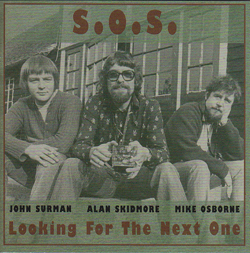
Way back in the early 70's (according to Melody Maker's annual poll) John Surman was the UK's Musician of the Year and top baritone saxophonist, while Alan Skidmore was top tenor saxophonist and Mike Osborne top alto saxophonist. The three frequently played together in such groupings as Brotherhood of Breath and the Mike Westbrook band, as well as on each other's recordings, notably Surman's How Many Clouds Can You See? (Deram 1970). In April 1973, they took the unprecedented step of forming S.O.S. of which they were the sole members. At the time, saxophone-only groups were unheard of — World Saxophone Quartet and ROVA would not be formed until 1977. In fact, although all three members of S.O.S. were renowned saxophonists, it was not solely a saxophone trio; Skidmore occasionally played drums, while Surman was increasingly employing a synthesiser with sequencers and components to create loops.
Despite that, the dominant sound of S.O.S. was of three equally matched but contrasting saxophones blowing simultaneously, creating lines that complemented each other perfectly, overlapped and interwove into a rich tapestry of sound. The group were electrifying in concert, using themes as the starting points for extended collective improvisations which would often last about half-an-hour. Until now, the only available recorded evidence of the trio has been S.O.S. (Ogun, 1975). Studio-recorded in January and February 1975, it has served as a fine reminder of the trio but never replicated the energy and power they generated in a live setting. Looking for the Next One is a double album which remedies that under-documentation of S.O.S: disc one consists of three studio-recorded tracks from late 1974 and three from September 1975 — so they bracket the Ogun recordings; more excitingly, disc two contains their entire set from the July 1974 Balver Höhle Jazz Festival in Germany.
The studio-recorded tracks largely avoid duplicating the content of that Ogun album — the jaunty group composition "Country Dance" being the only piece in common — and expand the picture it painted. Although enchanting, Surman's synthesiser interludes could occasionally be too long and repetitious, breaking the mood and slowing things down. Two tracks that are highlights of disc one remedied that by adding the late great drummer Tony Levin to the trio; he drives the group along, generating great momentum and excitement. With Levin as a permanent member, S.O.S. would have been even more awe-inspiring. Despite the quality of disc one, the live disc (running for over sixty-seven minutes, with two of its five tracks far exceeding twenty minutes) is the greater revelation and seems certain to open many eyes and ears to the delights of S.O.S. Looking for the Next One is undoubtedly a release of great historical significance but, far more importantly, it sets the pulses racing and makes great listening. Simply essential.
Comments and Feedback:
|



